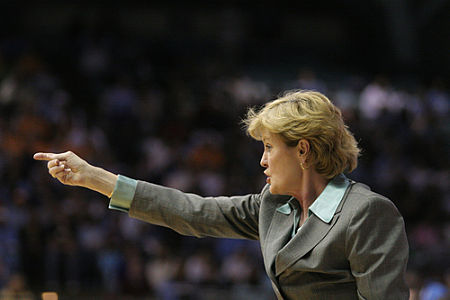Glass Ceiling Still Intact In Women's Basketball

The number of females coaching women's college basketball, like Tennessee
coach Pat Summitt, has been on the decline since 1990.
(Creative Commons licensed)
This article can also be seen on Kevin Patra's Web site, TheSportsUnion.com.
All the men's college basketball teams, from dancing champion UNC down to those who never stood a chance of playing in a post-season tournament, have one thing in common: Male head coaches.
Women have succeeded in breaking barriers in the high-profile professions of law, medicine and politics; however, the number of women coaching Division I men's college basketball remains at zero.
"I think there is a double standard," said Celia Slater, NCAA Women Coaches Academy executive director. "When men apply for women's jobs, no one says, 'You know you've never coached women before.' When women apply for men's jobs, they get the question, 'Well you've never coached men before; how do we know you can coach men?' It's like anybody can coach women."
The Women's Basketball Coaches Association released a study indicating that 66 percent of women's Division I basketball teams are coached by females--a number that has fallen 6.7 percent since 1990. The number of female head coaches of all men's sports remains between 2 to 3 percent, most of which are in 'individual' sports such as tennis, track or swimming, and in basketball it is non-existent.
Betty Jaynes, who was the WBCA's first chief executive officer and now works as an administrative consultant, said that with most professions, women have struggled to climb the ladder.
"I've never coached men, but from the actual game there is no difference," said Jaynes who coached at James Madison University from 1970-1982. "I've heard Pat Summitt and Sylvia Hatchell talk about working with men coaches and counting on each other for education, so that would give me the impression there is not a lot of difference in Xs and Os."
University of Southern California Senior Associate Athletic Director Steve Lopes believes that one reason for the lack of women head coaches is that few even have the desire.
"Coaching is a terribly dysfunctional profession," said Lopes. He added that if a woman wanted to start a family, coaching would probably not be the greatest profession for her because of the time commitment and demands of the job.
Lopes said that when USC--which employs a male head coach for both the men's and the women's team--hires a coach, it tries to find the best possible candidate regardless of race or gender. "The pool is what it is," he said about the lack of interest in women to be head coaches, especially for men's teams.
"I have not heard women say that they wanted to coach men's basketball," said Jaynes. The main interest is in coaching women's basketball and driving the women's game, she said.
As with many professions, it is not the job's details that would stop women from landing a job as the head coach of a high profile men's team; it is the perception.
"I think she would be ridiculed on the recruiting highway. I think it would be hard because she would be stereotyped because she's never had a track record," said Jaynes. "Not that she wouldn't be able to work through it, but it would be a tough road."
"There has been some discussion, for example, Pat Summitt - could she coach men's basketball and be successful?" said Brett Steele, a former Division III college basketball player and coach, and athletic director at Redford Union High School outside of Detroit, Mich. "I don't think there is any question she could coach men's basketball and be successful. As many women coaches could, the hurdle would be the recruiting."
Prejudices about women's coaches are one hurdle that would make it difficult for a female men's head basketball coach, said Steele. "People may say, 'Why would you want to go play for a woman when you can play for someone else?' And that initial period of just getting into communication with a family or student athlete can make it difficult," he said.
Slater, whose academy trains coaches and helps to serve as an aid for both female coaches looking for positions and athletic directors searching for qualified candidates, said part of the struggle comes from hiring practices.
"There are women out there who enjoy coaching men, just as there are men who enjoy coaching women," said Slater. "But will they get the opportunity? Right now in most women's realm of thinking, they don't even think it's a possibility."
R. Vivian Acosta, Ph.D. and Linda Jean Carpenter, Ph.D., J.D., in their study, "Women in Sports," said that women in administrative positions directly influence the hiring of women coaches. In Division I basketball, women coaches have a 5 percent higher rate of employment under female athletic directors than under male athletic directors.
While opinions differ as to whether administrative decisions or disinterest from qualified candidates is the reason females have not made the move into coaching men's college basketball, many believe the question is not if it might happen; the question is when.
"No question, it will happen eventually," said Steele. "But it's going to take an athletic director who is willing to take a risk with a challenging situation."
"I think the generation of young men who have been coached by women are going to break through in other sports," said Slater, "And they are going to become athletic directors and are going to say, 'What's the big deal about having women coaching our men's basketball teams?'"



